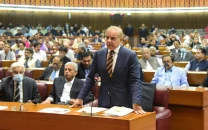“Our men want ten children”
Govt effort to promote family planning has failed as officials are selling instead of distributing contraceptives.

A week before Mr Gilani visited Dadu, I visited an IDP camp in the same area where an LHW, Sakina, who is now one of the IDPs from Khairpur Nathan Shah, told me that she had not been receiving her monthly supply of contraceptives for the past six months. As a result, most of the women in her village of 150-200 households are now expectant mothers. In some cases, these expectant mothers already have six or seven children, Sakina goes on to tell me and then leans forward to whisper: "Baji, yahan ke mard kehte hain kam se kam das bachhay to hona chahiye" (The men in our village want 10 children, at least).
Until six months ago, Sakina, a mother of four, was able to put an end to this practice by increasing access to contraceptive services in her village. But with allegations of corruption against EDOs who are reportedly selling condoms and oral contraceptive pills meant for women in the rural areas to make some ‘extra money’, the government effort has once again proved to be futile.
Before 1991, efforts of the government to promote family planning were largely disappointing and it was since the inception of the Lady Health Worker Programme (LHWP) that contraceptive use more than doubled in 2001. This later went up to 37.6 per cent in 2006-07, according to the latest figures available on the website of the ministry of population welfare. In collaboration with the ministry of health, the idea was to integrate family planning with LHWP so services could be provided at the doorstep along with provision of primary health care. As statistics show, they also succeeded in doing so for a while until the flood exposed the corruption in this (yet another) sector. Senior obstetricians who visited the flood-affected regions repeatedly pointed towards the need to control the country's birth rate that currently stands at 3.43 births per woman. According to the UNFPA, of the 18 million displaced by the floods, 70 per cent are women and nearly 500,000 of them are expectant mothers. At this rate, the country’s rising population will only give rise to more poverty, which Pakistan is ironically committed to reduce by 2015 if it intends to meet the Millennium Development Goals.
Failure to do this will ‘tarnish the country’s image’ Mr Gilani, not the delay in provision of Watan Cards. Let’s set our priorities right first.
Published in The Express Tribune, December 13th, 2010.

1729685382-0/Untitled-design-(57)1729685382-0-208x130.webp)














COMMENTS
Comments are moderated and generally will be posted if they are on-topic and not abusive.
For more information, please see our Comments FAQ